| Article ID | Journal | Published Year | Pages | File Type |
|---|---|---|---|---|
| 4735578 | Quaternary Science Reviews | 2013 | 19 Pages |
Mechanisms of climatic control on river system development are still only partially known. Palaeohydrological investigations from river valleys often lack a precise chronological control of climatic processes and fluvial dynamics, which is why their specific forces remain unclear. In this multidisciplinary case study from the middle Elbe river valley (northern Germany) multiple dating of sites (palynostratigraphy, radiocarbon- and OSL-dating) and high-resolution analyses of environmental and climatological proxies (pollen, plant macro-remains and ostracods) reveal a continuous record of the environmental and fluvial history from the Lateglacial to the early Holocene. Biostratigraphical correlation to northwest European key sites shows that river system development was partially out of phase with the main climatic shifts. The transition from a braided to an incised channel system predated the main phase of Lateglacial warming (∼14.6 ka BP), and the meandering river did not change its drainage pattern during the cooling of the Younger-Dryas period. Environmental reconstructions suggest that river dynamics were largely affected by vegetation cover, as a vegetation cover consisting of herbs, dwarf-shrubs and a few larger shrubs seems to have developed before the onset of the main Lateglacial warming, and pine forests appear to have persisted in the river valley during the Younger Dryas. In addition, two phases of high fluvial activity and new channel incision during the middle part of the Younger Dryas and during the Boreal were correlated with changes from dry towards wet climatic conditions, as indicated by evident lake level rises. Lateglacial human occupation in the river valley, which is shown by numerous Palaeolithic sites, forming one of the largest settlement areas of that period known in the European Plain, is assigned to the specific fluvial and environmental conditions of the early Allerød.
► First high resolution record of Lateglacial fluvial dynamics in the Elbe system. ► New insights into the timing and climate dependency of fluvial processes. ► Fluvial development was partially out of phase with main climatic shifts. ► Vegetation cover as an important factor in controlling river system evolution.
